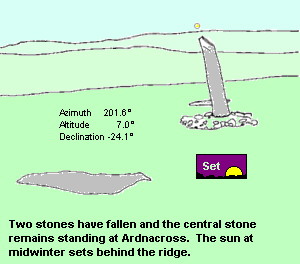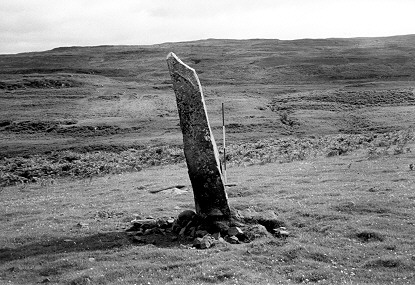
Ardnacross, Mull
Ardnacross, Mull - a page describing the ancient standing stone alignment at Ardnacross, on the island of Mull
Stones of Wonder
QUICK LINKS ...
HOME PAGE
INTRODUCTION
WATCHING
THE SUN, MOON AND STARS
THE
MONUMENTS
THE
PEOPLE AND THE SKY
BACKGROUND
ARCHAEOASTRONOMY
USING
THE SITE DESCRIPTION PAGES
VISITING
THE SITES
THE
LEY LINE MYSTERY
THE
SITES
ARGYLL
AND ARRAN
MID
AND SOUTH SCOTLAND
NORTH
AND NORTH-EAST SCOTLAND
WESTERN
ISLES AND MULL
Data
DATES
OF EQUINOXES AND SOLSTICES, 1997 to 2030 AD
DATES
OF MIDSUMMER AND MIDWINTER FULL MOONS, 1997 to 2030 AD
POSTSCRIPT
Individual
Site References
Bibliography
Links
to other relevant pages
Contact
me at : rpollock456@gmail.com
Standing stone (Alignments) NM542491*
How to find: The site is 6km north of Salen, or 9km south of Tobermory on the A848, which runs along the east coast of Mull. A short stretch of track to the west of the road gives access to the open ground (turn right just before reaching the buildings); a walk of about 300m uphill brings the remaining standing stone into view. The stone is not visible from the road.
Best time of year to visit: Midwinter sunset, December 21st/22nd.
 This
site once consisted of six large stones set in two alignments of three stones each; five of the
stones have sadly fallen and only one remains upright - it is about 2.5 metres tall. The alignments
were parallel but not beside one another. There are also three kerb cairns close by, the chronological
relationship of these to the alignments being unknown. This must have once been a most spectacular
and important monument, set on a flat terrace above the Sound of Mull. Recent excavations around
the stones have revealed that the area was originally cleared of hazel scrub by burning. It was
also found that the two outer stones of each row were deliberately knocked over, with the central
stones left standing; the central stone of the northern row fell of its own accord1.
This
site once consisted of six large stones set in two alignments of three stones each; five of the
stones have sadly fallen and only one remains upright - it is about 2.5 metres tall. The alignments
were parallel but not beside one another. There are also three kerb cairns close by, the chronological
relationship of these to the alignments being unknown. This must have once been a most spectacular
and important monument, set on a flat terrace above the Sound of Mull. Recent excavations around
the stones have revealed that the area was originally cleared of hazel scrub by burning. It was
also found that the two outer stones of each row were deliberately knocked over, with the central
stones left standing; the central stone of the northern row fell of its own accord1.
It is the middle stone of the southern alignment which survives. It is 2.4m high. The prostrate northern stone of this alignment appears to be lying off the line connecting the long faces of the upright and the base of the southern stone, though it is possibly just partly buried under the turf.
The line to the north-east is on a bearing of 21.6°, which with a horizon of just under 2° gives a declination of over +32°, which is of no known astronomical significance.
The line to the south-west however, on a bearing of 201.6°, with an apparent horizon height of 7° gives a declination of -24.1°. So the alignment indicates the midwinter setting sun, which goes down behind the high and featureless flat ridge to the south west.
Close by is the second alignment of three stones, all of which have fallen. If we assume that all these stones fell to the east (the same way as the two fallen stones of the other set) then the line along the bases gives a bearing to the south-west of 196.6°, which also produces a declination close to that of the sun at midwinter.-

The remaining upright stone at Ardnacross.